The Apple Thunderbolt Display Review
by Anand Lal Shimpi on September 23, 2011 2:56 AM EST- Posted in
- Displays
- Mac
- Apple
- Thunderbolt
- Thunderbolt Display
Ever since I moved to a notebook as my main work computer I've become increasingly annoyed with the process of actually moving my notebook-as-a-desktop around. At my desk I've got DisplayPort, Ethernet, two USB, FireWire 800, speakers and power all plugged into a 15-inch MacBook Pro. What makes it frustrating isn't the first-world-problem of having to unplug seven cables, rather that it doesn't need to be seven cables - Apple could make the whole thing happen with just two.
Every Mac released in 2011 has at least one Thunderbolt port (the iMac has two), and Thunderbolt can deliver exactly what I'm looking for. Thunderbolt can carry two things: PCI Express and DisplayPort, the former for data and the latter obviously for video. Why would you want to carry PCIe and DP over a single cable? To address problems like the one above.
Pretty much all device expansion on modern day PCs happens via PCI Express. Several years ago it was hard to find PCIe sound cards or Ethernet controllers, but these days vanilla PCI slots are nearing extinction and PCIe is the de facto standard. Ethernet, USB and FireWire controllers all exist as single-lane PCIe devices. Put a bunch of them at the other end of a Thunderbolt cable and you no longer need to plug in a bunch of individual cables into your notebook when at your desk. Send DisplayPort over the same cable and you can actually move all of those ports onto your monitor, thereby using a single cable to carry everything but power to your display. And this is exactly what Apple has done with its new Thunderbolt Display. By mating its 27-inch LED Cinema Display with a bunch of integrated IO controllers, Apple is hoping to deliver a display that's more of a mobile docking station than just a passive way to display video.
Apple has tried this in the past. The old Cinema Displays used to feature an Apple Display Connector (ADC) that actually carried DVI, USB and power from a desktop Mac to the monitor. You only needed to plug in a single cable to your display, significantly reducing desktop clutter. Although Thunderbolt does carry power, it's limited to 10W - not enough to power any reasonably sized display. Where Thunderbolt does win out over ADC however is in its universal appeal. Intel created the standard. Although it's used almost exclusively on Apple systems today, come 2012 Intel is expecting PC OEMs to embrace the interface with its Cactus Ridge line of Thunderbolt controllers.

Apple's Thunderbolt Display
The Thunderbolt Display uses a near, if not perfectly, identical panel to what was in last year's 27-inch LED Cinema Display. You get a 27-inch, 16:9, 2560 x 1440 LED backlit display capable of at least 350 nits at full brightness. Apple seems to conservatively spec its desktop displays as we were able to measure 425 nits at max brightness. The uber brightness comes in handy because the display does have a glossy finish. Indoors it's not really a problem unless you're watching a dark movie scene with the display lit by a sun-facing window. Even then, cranking up the brightness all the way is usually enough to overcome any significant glare. As with all glossy displays, if you have light control (e.g. curtains or blinds) you'll be just fine.
The similarities don't end with the internal panel, the chassis is very similar to its older sibling and the Thunderbolt Display retails for the same $999 price.
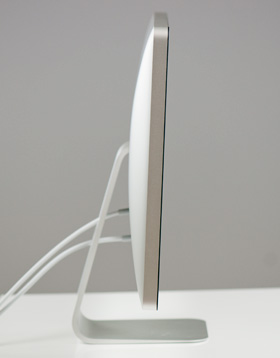 |
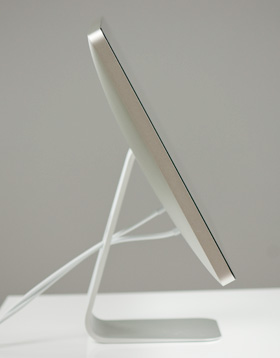 |
The display sits on an aluminum swivel base that allows for -5 degrees to 25 degrees of tilt along the horizontal axis. There's no height adjustment for the display either, only tilt. Personally, I use a height adjustable desk as I find it helps me avoid any carpal tunnel pain. Combined with a height adjustable chair, the lack of height adjustment on the display doesn't bother me. If you have a fixed height desk however, this may be a problem.
Aesthetically the Thunderbolt Display continues Apple's aluminum meets glass design language. The front of the display is all glass, while the edges and back are all aluminum. Along the top surface of the display is a mic for the integrated FaceTime HD camera. The outgoing 27-inch LED Cinema Display (still available for purchase online) sported a 640 x 480 camera, while the Thunderbolt Display ups capture resolution to 1280 x 720.
There's an ambient light sensor hidden in the top bezel of the display, but as always you can disable its functionality from within OS X.

There are two integrated speakers in the display, again unchanged from the previous LED Cinema Display.
Two cables attach directly to the display: a removable power cable and an integrated IO cable. Cable management is done through a round cutout in the aluminum stand. The IO cable is where things really change with the Thunderbolt Display. Instead of a breakout of three cables as was the case with the Cinema Display, there are now only two: MagSafe and Thunderbolt.
The MagSafe connector remains unchanged. If you've got any Mac that can be charged by an 85W MagSafe adapter, the Thunderbolt Display will charge said Mac. This feature alone is particularly awesome for notebook-as-a-desktop users since it allows you to just keep your actual AC adapter tucked away in your travel bag. For me I keep my MagSafe adapter in my bag and never take it out so I never have to worry about forgetting to pack it. Given how expensive MagSafe adapters are ($79 for an 85W), this is a nice feature for MacBook Air/Pro owners.
The Thunderbolt cable is obviously what gives this new display its name. Inside the Thunderbolt Display is an Intel Light Ridge Thunderbolt controller. The type of controller is important as it bestows upon the display some clear limitations. The biggest of course is the lack of support for all non-Thunderbolt systems. That's right, the only way to get video to the Thunderbolt Display is by using a Thunderbolt enabled Mac (or theoretically a Thunderbolt enabled PC). For Mac users that means only 2011 MacBook Pro, Air, iMac or Mac mini models will work with the Thunderbolt Display. Everyone else has to either buy a new Mac or stick with older displays.
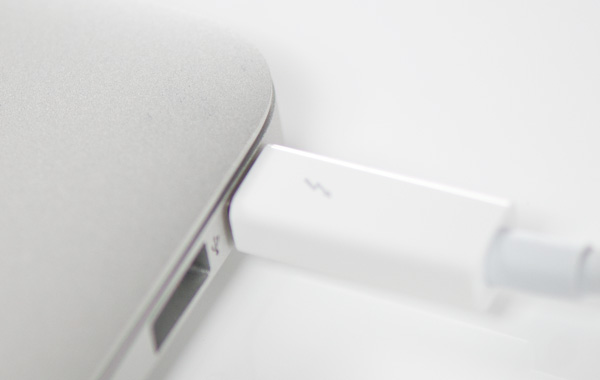
I believe the limitation here is actually on the cable side. A Thunderbolt cable can only transmit a Thunderbolt signal. Although DisplayPort is muxed in, if the display on the other end is expecting Thunderbolt and it receives DisplayPort it won't know what to do with it. It's possible Apple could have built in logic to autosense and switch between Thunderbolt and DisplayPort as inputs, but Apple traditionally employs clean breaks rather than long technology transitions. If Apple wants to ensure Thunderbolt gets adopted (at least by its users), this is the way to do it. As we learned from other legacy interfaces (e.g. PS/2, IDE), if you enable backwards compatibility you'll ensure the survival of systems that implement those interfaces. It's not so great for existing customers unfortunately.


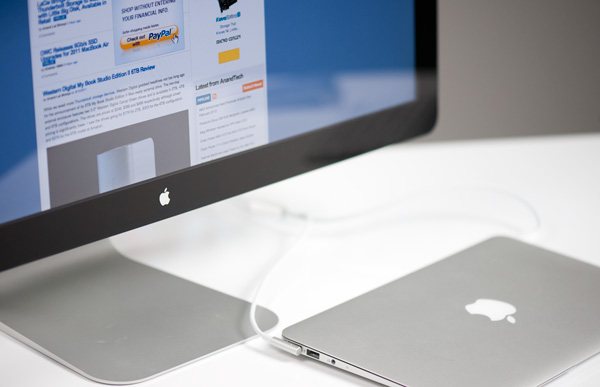
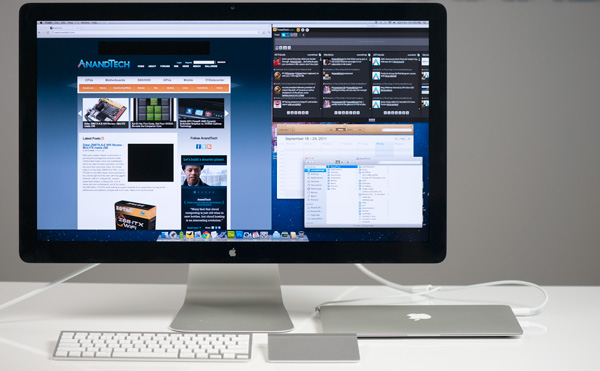
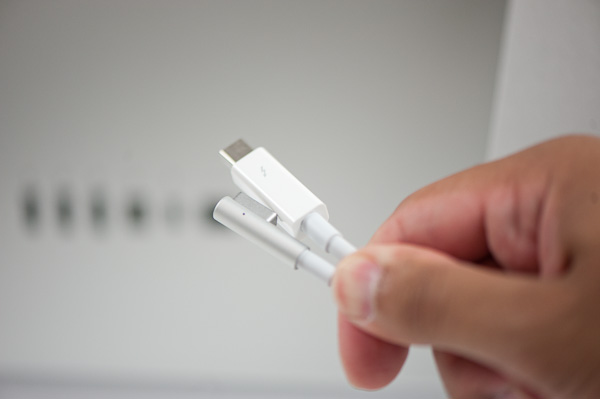








275 Comments
View All Comments
Omid.M - Saturday, September 24, 2011 - link
Anand to smile at the camera and point to the lower right of the screen at a QR code that launches a mail client with a URL to the review...to share with others. Oops, thinking outloud.@moids
You get my email a while back, Anand? I know you've been slammed with your schedule!
nameless_1 - Saturday, September 24, 2011 - link
You could have this ten years ago without plugging any cables at all, not even two. Just buy a docking station for your laptop. Or is the news that it is finally possible on a Mac...ufon68 - Saturday, September 24, 2011 - link
Awesome video.Death666Angel - Saturday, September 24, 2011 - link
"Thanks to SSDs, Turbo Boost and Thunderbolt the only thing holding notebooks back from being true desktop replacements is GPU performance."And the fact that performance per buck is still about 3 to 5 times worse than any desktop PC. Unless you are very well off or need a notebook for your work, chances are, you can't afford a real desktop replacement notebook.
tommyj - Saturday, September 24, 2011 - link
A typical i5 laptop, which is like $600 (Thinkpad Edge), basically does what a typical desktop does extremely well and comes with a keyboard, pointing device, and screen if you are really destitute. As Anand said, the only thing holding them back is the GPU and frankly a lot of people cannot really use one properly (if you don't play games and don't dabble with professional applications, its going to sit idle). Spend another $100-250 and you can throw a very nice SSD to make it feel really snappy.If you want to bring up Apple, the base Macbook Air is like $1000 and its powerful enough for every task people need to do. For most users, even those who use their machines for prosumer purposes, processor speed becomes less of a necessity but a luxury really.
Increasingly, people are finding desktops less and less worthwhile. The only reason I still own, and upgrade, mine is because it can hold the latest and greatest GPU.
bigpics - Saturday, September 24, 2011 - link
As someone else pointed out to me, notebook performance, especially light-weight notebook performance is changing on more important variables more quickly than monitor tech.So this monitor suggests a new cost effective strategy for a one-machine-to-do-it-all setup. This should work out well as long as you don't need the latest, latest performance bumps in the MBP line while on the road (or the top iMac performance at home).
The strategy is to buy the best MB Air + this monitor, and then replace the CPU piece every year or two - when the available air performance will stay equivalent to the performance of a one or two year old pro. (And note that while some performance is incrementally sacrificed, portability is incrementally increased - AND you get this gorgeous screen - which might meet some users' needs better in the first place.)
Here's a current high-end MBP 15":
$2,999.00
2.2GHz Quad-core Intel Core i7
8GB 1333MHz DDR3 SDRAM - 2x4GB
256GB Solid State Drive
SuperDrive 8x (DVD±R DL/DVD±RW/CD-RW)
MacBook Pro 15-inch Hi-Res Glossy Widescreen Display
And here's a current high-end MBA 13.3" INCLUDING the Thunderbolt monitor:
$2777.00
Apple Thunderbolt Display (27-inch) ($999)
MBA 13.3" ($1778)
1.8GHz Dual-Core Intel Core i7
4GB 1333MHz DDR3 SDRAM
256GB flash storage
External Apple MacBook Air SuperDrive
Of course some of you might need and be able to get both the MBP and the monitor - lucky you, but let's say you have SOME real world budget constraints, and over the next six years, you replace the MBA twice (at 2 and 4 years in) as it advances, and the MBP once (3 years in).
Assuming constant prices - not entirely unreasonable with Apple speculation - and a 6 year usable lifetime for the monitor (even though it will certainly be upgraded with, say, USB 3 and more - but the same cost to replace in either strategy), here's your total bill (exclusive of other peripherals, cables, etc.):
1. You have this monitor and a three year old MBP 15":
$6997 spent.
(Add the cost of iPads if the MBP is just too much for some outings and you need something lighter)
2. You have this monitor and two year old MBA (of whatever "):
$6333 spent.
So a reasonable approach I would say (and even wonder if Apple's not encouraging it in some ways). Consider one last comparison - your best stay at home (no notebook capabiity) iMac options. And we'll specify that some of you will want more net and more capable apps on the road than you can get on your phone, so you'll meet your away from home needs with three baseline iPads over the 6 years
3. So here's for two top of the line iMacs and possible iPads:
$6798 spent on iMacs
$1497 on iPads
$ 8295 spent
One more cost saving (over a height adjustable desk) possiblity: a. Old phone books (free) and b) height adjustable chairs (a few hundred more at most).
sreams - Saturday, September 24, 2011 - link
When you close the Macbook Air, you aren't "sleeping" it. You're just closing it.dsumanik - Sunday, September 25, 2011 - link
nice production sound, and dialogue on the video..well done.Some problems though unfortunately:
"Personally, I use a height adjustable desk as I find it helps me avoid any carpal tunnel pain. Combined with a height adjustable chair, the lack of height adjustment on the display doesn't bother me."
Uh huh.
I should buy this display and get an adjustable desk.
Thats the OBVIOUS solution.
Not only a facepalm by apple's designers...(i mean how hard would it be to make it adjustable a few inches?) but also a total facepalm in the pro apple bias department.
This review was a commercial for apple, plain and simple.
Why not start accepting payment from apple?
You might as well if you gonna be a part of thier marketing team.
Your own words:
"a must have item for macbook owners"
PFFFFFFFFFFFFFFFTTTTT.
ill save people the 15 minute advertisement;
pros:
single cable to connect and charge
nice material and design
cons:
-no sound
-no usb 3
-incompatible with anything but 2011 macbooks
-1000 dollars (i could buy 5 1920x1080 displays for same price)
-you need to buy an adjustable desk and chair
Amazing what you can sell people if it comes in a nice shiny package...even a seasoned, unpaid, objective and intelligent reviewer fell for it hook line and sinker.
hey apple if you reading this...
Where my integrated iphone dock?
Constructor - Sunday, September 25, 2011 - link
He simply said that he had that anyway, so the lack of height adjustability didn't bother him.
And I shudder to think how heavy and still wobbly a height-adjustable stand would have to be for my 27" iMac. The TBD is not quite as heavy, but I rather live with an additional socket to get it to the desired height for me than dealing with the usual wobbly mechanism I know from other monitors (such as the secondary Samsung next to the iMac, which also needs an additional stand to get it high enough). I'm rather tall and most adjustable stands end too low anyway, so there would be no benefit for me anyway.
Quite hard to make it really sufficient. Just "a few inches" are worthless. Inclination adjustment is enough for that. And making an iMac 27" or a TBD adjustable by the amount I really needed would make the stand very wobbly and/or very heavy and very wide.
This is a lot more difficult than you seem to get.
"Pfft" indeed. You completely misrepresent what Anand actually said: "For MacBook Air owners who don't have options for these high speed interfaces to begin with, the Thunderbolt Display is a must-have."
Further: For me the Thunderbolt Display is good but not perfect. I wish it had a 1/8" stereo output, an SD card reader and USB 3.0 support. Give me those things and I'd be ecstatic. There's always next year's model.
It seems you are the one who's suffering from a heavily distorted perception here.
- very high resolution (2560*1440) high-grade IPS display
- multiple expansion ports, including Gigabit Ethernet and FireWire 800
- built-in speakers, microphone and HD webcam
Wrong. It's got built-in speakers (and a microphone). It only has no additional audio output socket (every MacBook has one already built in).
Also wrong. All recent iMacs and Mac minis plus all further upcoming Macs plus many upcoming PCs will also be able to use it.
Sure. The problem is that they are low-grade TN displays with a much lower resolution with not much more than half the number of pixels of the TBD, which also has a much higher-grade IPS panel.
I've got one of those lower-grade TN panels as a secondary monitor next to my iMac 27", and the difference both in resolution and in contrast range is substantial. The Apple display is definitely worth its price, even and especially in direct comparison, which I have.
I'm tempted to replace that secondary display with another Apple 27" display.
Nonsense. I've just propped it up on a socket on the table. And most shorter people won't even need that.
It seems you've had trouble understanding both the product and the review yourself.
If you have no use for a product on that level, that is perfectly all right. But other people do have an interest in new technology, and reviews like Anand's, which went very much into the depths of the new base technology, are among the reasons why technology journalism has an important role to begin with.
Apple just happens to be the one pushing this new technology. If you want to complain about something, complain about PC manufacturers sitting on their hands while Apple is running away with new technology and an increasing share of the market profits earned.
Constructor - Sunday, September 25, 2011 - link
Quoting seems to be broken. There have been paragraphs (double newlines) between the quotes and the comment. Weird.